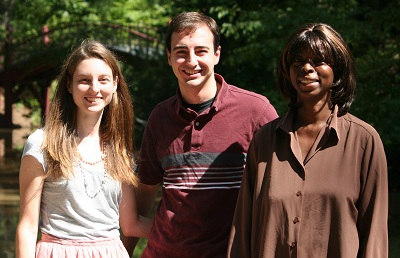McMillan, Providence, Thorne receive NASA VSGC STEM Research Fellowships
 Graduate
students Collin McMillan, Judith Providence, and Jennifer Thorne each
received a Virginia Space Grant Consortium 2011-2012 Graduate STEM
Research Fellowship.
Graduate
students Collin McMillan, Judith Providence, and Jennifer Thorne each
received a Virginia Space Grant Consortium 2011-2012 Graduate STEM
Research Fellowship.
A major goal of the Virginia Space Grant Consortium (VSGC) is to help produce the engineers and scientists of the future. While opportunities for careers in aerospace have expanded, the number of talented students pursing degrees in science, technology, engineering, and mathematics (STEM) has declined. To encourage talented individuals to pursue aerospace-related fields of study, the VSGC established four Scholarship and Fellowship programs. The Graduate Research Fellowships are $5,000 awards for students enrolled at a Virginia Space Grant university (College of William & Mary, Hampton University, Old Dominion University, University of Virginia, and Virginia Tech) pursuing any field of graduate study (Masters or Doctoral level) with aerospace relevance.
Collin McMillan works in the area of source code search and retrieval. His work uses structural data from source code, such as function calls or commit logs, in order to improve search in large projects or repositories. One application of this work of direct relevance is to projects that persist for years or decades. As new programmers enter these projects, they need to find which source code artifacts (functions, classes, etc.) relate to their tasks, such as the fixing of bugs, the addition of features, etc.
Judith Providence examines execution traces for the software development of safety critical systems, another important problem for NASA. Her research focuses on determining the similarity between execution traces in a way that is orthogonal to natural language processing techniques that apply to textual error description.
Jennifer Thorne works on tactical runway configuration management, the end goal of which is to provide a tool that will effectively and accurately recommend the optimal runway configuration strategy to meet all requirements of an airport over a certain time period. An automated runway configuration management model that optimizes its configuration choices to minimize delays in arrivals and departures will improve efficiency at airports especially when applied to several airports operating together in a metroplex. Such a model could help solve one of the main sub-problems of air traffic management.














